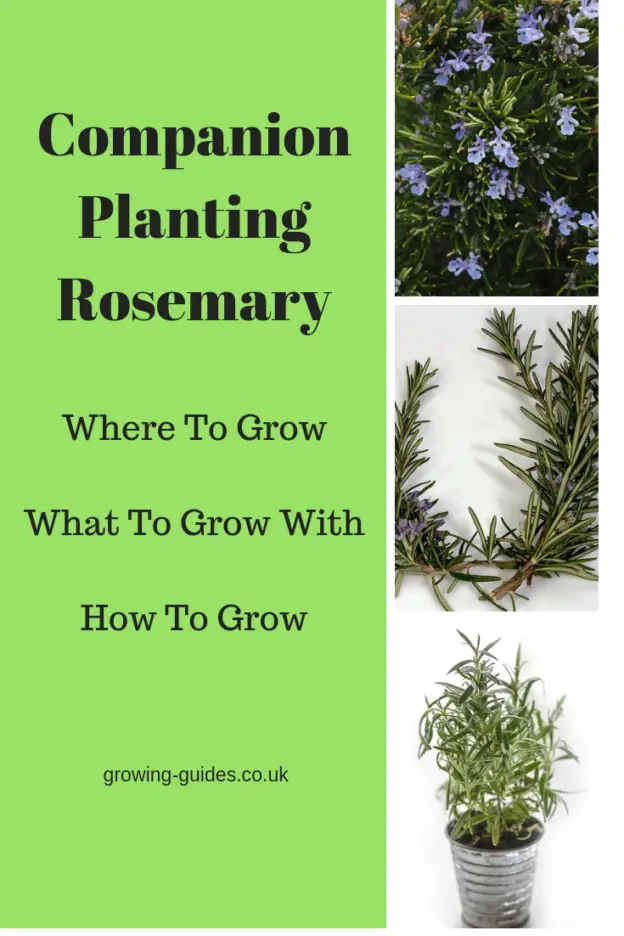Rosemary is a well known herb that is used with great success in the kitchen. Most people whether gardeners or not will recognise Rosemary probably by it’s leaves but definitely by it’s aroma. What is not so commonly known is the benefits of companion planting Rosemary in the vegetable patch.
Companion Planting Rosemary
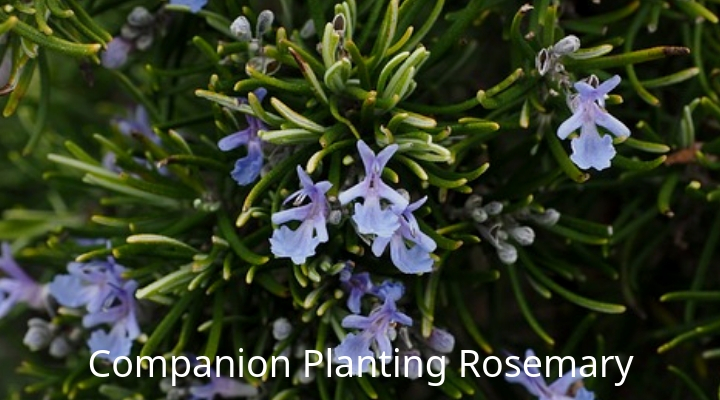
Companion planting rosemary in your garden brings numerous benefits to the plants around it, making it one of my favourite herbs to grow.
When you put all the hard work and effort into growing plants in your garden, there is nothing more soul destroying than having them destroyed by pests (especially when it can be avoided!)
Rosemary has a strong, distinctive smell that can help to keep many pests away from your garden (more on that later).
So here is a break down of the plants that grow well with rosemary:
Companion Planting Rosemary with Cabbage
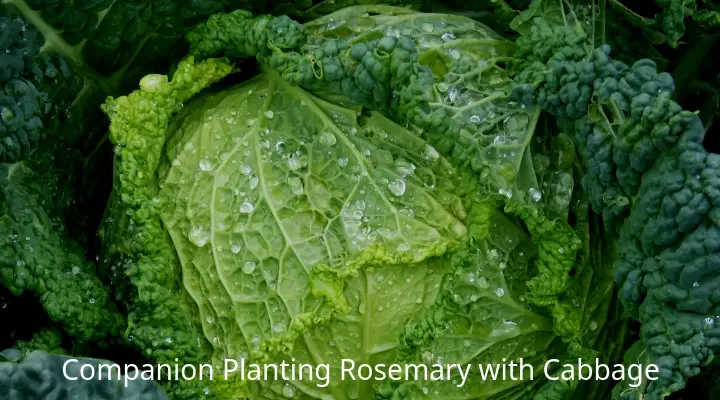
A massive problem cabbages have is their attractiveness in the eyes of Moths and Cabbage White Butterflies.
These Moths and Cabbage White Butterflies see your cabbages as a great place to lay their eggs.
When their eggs hatch, you are left with caterpillars all over your cabbage patch.
What’s The Problem With Caterpillars?
These caterpillars can decimate a cabbage patch in double quick time, leaving you with half eaten cabbages.
Now the scary thing about these caterpillars is the speed they can get through your cabbages. Because even if they are 100% free from them today, they can be fully infested with caterpillars, that will be boring their way through your crop – in just 4 days!
If you spot them in time you can can pick them off by hand.
But when you bear in mind, that each Moth or Cabbage White Butterfly can lay up to 100 eggs at a time… your problem is, you cannot protect them 24/7.
The way these Moths and Cabbage White Butterflies find your cabbage patch is by the cabbages’ distinctive smell.
So one of the best ways to keep them away from you crop, is to companion plant them with rosemary.
Rosemary has a stronger aroma than cabbage, and actually disguises them from these pests.
The way I feel about planing rosemary with my cabbages is that I’ve got something constantly guarding them for me.
Some may still be able to get through, but you can usually relax in the knowledge that the majority of your cabbages will be safely hidden from the Moths and Cabbage White Butterflies.
But that’s not all,
This exact same logic applies to all members of the Brassica family, including:
- Brussels Sprouts
- Broccoli
- Kohl Rabi
- Turnips
- Swedes
- Cauliflowers
- And more
So companion planting rosemary with any of these plants will be a massive aid in keeping caterpillars away from them too.
Companion Planting Rosemary with Carrots
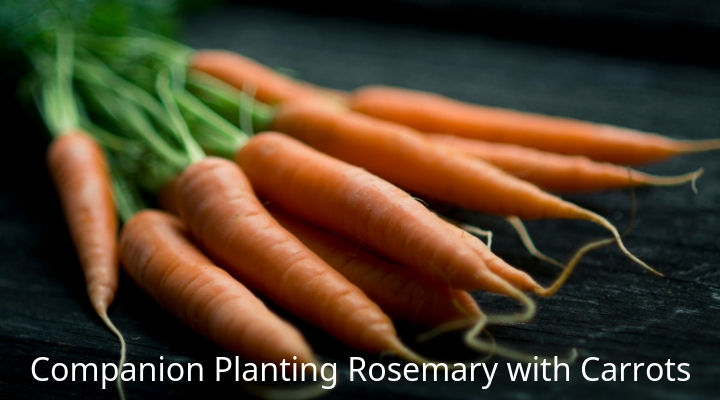
The biggest problem with growing carrots is their tendency to attract “carrot root fly”.
Now these carrot root flies are actually pretty harmless to your carrots…
The problem is that they lay their eggs in the soil, around the carrot seedlings.
These eggs hatch into tiny grubs that bore through the root of the carrot – ruining the part we want to eat!
One of the big issues with carrot root fly is that there is absolutely no warning. These flies simply find carrots, lay eggs and move on.
There’s nothing more devastating than lifting a perfectly healthy looking carrot – only to find that the root is actually full of those tiny brown holes.
How Carrot Flies Find Carrots
The way these carrot root flies find you carrots is by sniffing them out. This is made especially easy for them if you have recently disturbed your carrots by thinning the seedlings out or lifting them. Because as you lift them out of the ground – they give off a strong, distinctive smell of carrot.
The carrot fly is quick to identify your carrots and will lay their eggs and move on to someone else’s carrots.
One of the best ways to deter the carrot root fly is to companion plant them with a stronger smelling plant. This disguises the carrot plants and sends the carrot root fly off searching elsewhere for it’s off springs food.
And you don’t even need to plant whole rosemary plants around your carrots. Simply place cuttings around the tops of the growing carrots to over power the carrot smell and hide them from most carrot root flies.
Now if you are having issues with carrot root fly in your parsnips and celery, this exact same logic applies. Parsnips and celery both benefit from companion planting with Rosemary.
(Another tip to prevent carrot fly from carrots, parsnips or celery is to only lift them on windy days. So that the smell is carried away by the wind and any carrot root fly will keep on flying and searching elsewhere)
Companion Planting Rosemary with Beans

If you live in the US, you are probably all too away of the problems “Mexican Bean Beetles” cause for your bean plants. It’s not so much of a problem here in the UK, we have the pea and bean weevil which is a pest because it damages the bean plant leaves, but does not usually destroy bean plants.
But for the US, they are a problem.
In fact, they are a BIG problem.
These Mexican Bean Beetles are one of the only members of the ladybird (bug) family that is not an aid to the gardener.
What do Mexican Bean Beetles Do To Plants
The Mexican Bean Beetle (and its off spring) eat their way through your bean plants leaves, which makes them look like lace.
They attack the leaves from the underside and can actually strip the plant bare.
On rare occasions, they will even eat the beans too!
Plants use their leaves to photosynthesise sunlight and water into food.
This is how plants produce the energy they need to grow.
So if the Mexican Bean Beetle severely damages your plants leaves, or eats all the leaves off the plant – it will not survive.
Or if it doesn’t damage the plant so severely that it dies off, it can still stunt it’s growth, and stop it producing anywhere near as many beans as it should (if any at all).
Now the reason this happens is because your bean plants have a distinctive smell, that the Mexican Bean Beetles absolutely love.
These beetles fly around sniffing out plants to feast on, and beans to lay their eggs on.
So a great way to keep Mexican Bean Beetles away is to companion plant your bean plants with rosemary.
Rosemary’s strong aroma overpowers the scent given off by your beans and can help to hide them from the Mexican Bean Beetle.
If you don’t have many rosemary plants, you might also be able to get away with just spreading some rosemary cuttings around the beans.
Companion planting with rosemary may not keep your beans completely Mexican Bean Beetle free, but it will definitely deter most.
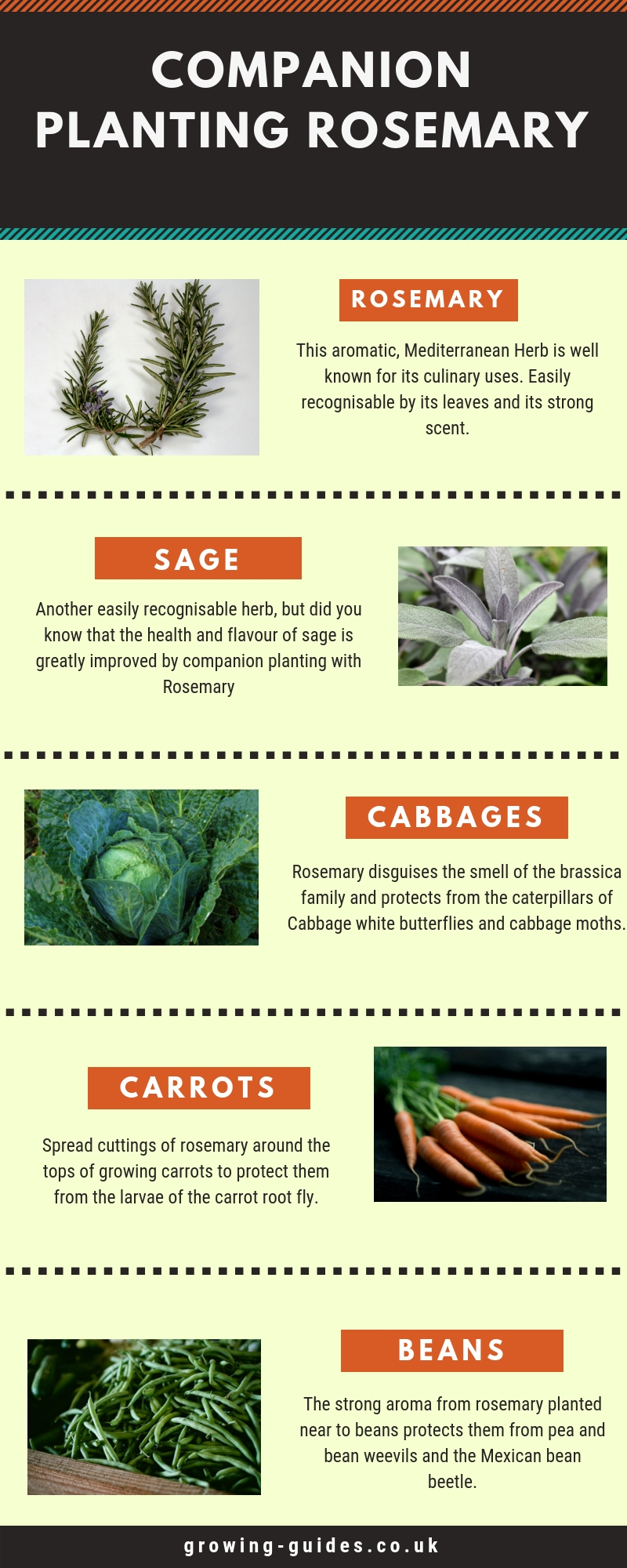
What Flowers To Plant With Rosemary
Any flowers that need similar conditions will be ok, so it’s a matter of personal choice. Rosemary thrives in full sun, at least 6 hours of sunlight per day is necessary to keep your rosemary plants healthy. Rosemary also doesn’t do so well if it is overwatered, in fact it likes quite dry conditions. Given these parameters there are flowers that will work well with rosemary.
Companion Planting Rosemary With Marigolds

Marigolds are a well known helpful companion plant, used to deter white fly and also to keep the soil free from eel worms. They also attract bees and other pollinators making them a beneficial companion plant in their own right. By companion planting marigolds with rosemary either in the ground or in pots they will give extra protection for your crops.
Companion Planting Rosemary with Other Herbs
Herbs that require similar growing conditions to rosemary include:-
- Sage
- Thyme
- Oregano
- Marjoram
- Lavender
The above can all be companion planted with rosemary and will all grow well together.
Other herbs that can be planted in companion with rosemary include, Parsley and Chives, these don’t usually like the same growing conditions but will get along nicely together. As parsley is of the carrot family the rosemary will also offer the same protection against the pests that bother the rest of the family.
Companion Plant Rosemary To Help Sage Grow
Sage and Rosemary get on particularly well together.Using Rosemary as a companion plant with Sage will improve the over all health of your Sage and the flavour in particular.
How To Propagate Rosemary
Rosemary can be grown from seed, it’s not the easiest of seeds to germinate and care will be needed. To be successful you will need to give a bottom heat of between 27-32 C (80-90F) starting in early Spring. Once the seeds have germinated, be careful not to over water as seedlings are liable to damping off.
Damping off (or damping-off) is a horticultural disease or condition, caused by several different pathogens that kill or weaken seeds or seedlings before or after they germinate. It is most prevalent in wet and cool conditions.[1]
The young plants should be hardened off slowly through the Summer and pot on as needed. Over Winter in a pot then plant out the following Spring.
Growing Rosemary From Cuttings
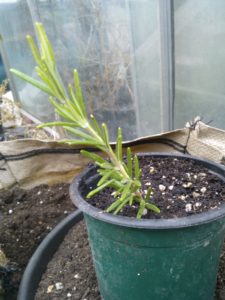
If growing Rosemary from seed sounds like too much of a bother, taking a cutting is a much simpler option. Always choose a healthy plant to take cuttings from because you are essentially making a clone of the original plant.
Softwood cuttings should be taken in Spring from new growth. Cuttings should be 6 inches long, remove lower leaves and stick in compost, keep moist but not water logged and they will take quite readily.
Hardwood cuttings should be taken in Summer from non flowering shoots in much the same way as softwood cuttings.
Propagation By Layering
Rosemary layers easily as the branches hang down, take an established branch in Summer and simply peg it to the ground. It will quickly establish roots and can then be transplanted.
Growing Rosemary In Containers-
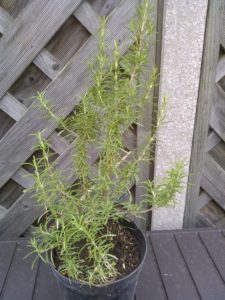
If you live in a cooler climate growing rosemary in pots and containers is preferable. Rosemary is considered to be hardy but in cold northerly areas it will need to be protected either by a wall/fence or by moving it to a more sheltered spot.
The compost should be free draining and don’t over water as this is the biggest cause of failure in container grown Rosemary. Only feed after the Rosemary has flowered. Feed with a dry fertilizer like blood, fish and bone.
General Care
It is worth remembering that Rosemary originates from the Mediterranean so it thrives in hot, dry conditions and does not need regular watering. It will also do best in fairly poor soils this can be achieved by adding grit to the soil. Which will also make the soil free draining another requirement for this aromatic herb.
Rosemary plants do best in full sun.
Pruning Rosemary
Once the plants are established there is little that needs to be done to them and they will eventually get “woody”. However by giving it a light prune every Winter you will slow the process of the stalk growing woody. This will also keep it looking tidy.
The pruning’s can be dried and used on barbeques, or open fires to spread that wonderful aroma throughout the house/garden. As Rosemary is easily propagated from cuttings, when they do get too woody just replace with new plants.
Medicinal Properties Of Rosemary
Rosemary oil is:-
- Anti-bacterial
- Anti-fungal
- Anti-septic
- Improves circulation-Rub into painful joints
- Relieves headaches-rub onto forehead
- Insect repellent
It is also said to make a effective mouth wash (but be careful as ingesting too much Rosemary can be toxic).
Rosemary repels aphids
There have been numerous scientific studies compiled over the years, and the results conclude that rosemary repels aphids from your host plants. If it’s not possible to grow rosemary close to your crop, just place some sprigs around your crop and keep the aphids away. Or spray your plants with a solution of rosemary oil in water, this has been found to be just as effective.
Rosemary repels mosquitoes
This may not be a pest to the garden, but rosemary has been said to repel mosquitoes. Which certainly makes your gardening experience more pleasant.

